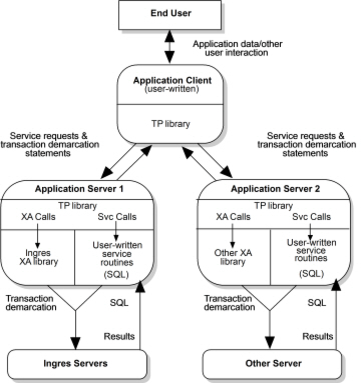XA Application Model
Application programs are typically divided into application clients and application servers:
• Application clients
Application clients interact with the end user and request services from application servers through the transaction processing system's transaction manager. The application client demarcates transactions using routines supplied by the transaction processing software vendor. The application client should not interact directly with underlying database management systems.
• Application servers
Application servers perform services on behalf of remote application clients. Typically, these services are registered with the transaction manager. The transaction manager relays transaction demarcation events to the resource manager by calling XA routines.
Both application clients and application servers must be linked with libraries provided by the transaction processing software vendor. Application servers must also be linked with the Ingres DTP XA library routines. Applications programmers need not be concerned with the XA routines, because these calls are performed by the TP system on behalf of the application program. For details about the calls that your application must issue to demarcate transactions, refer to the programmer documentation supplied by your transaction processing software vendor.
The following figure illustrates the structure of a typical Ingres DTP application:

This figure shows an application client that accepts data and other commands from an end user. The application client requests service from two application servers. One of the application servers communicates with several Ingres DBMS servers, and the other with a single, non-Ingres DBMS server. The application client is linked with a library of routines provided by the TP vendor. The application servers are linked with libraries provided by the TP vendor and libraries provided by Actian Corporation or the non-Ingres DBMS vendor.
Last modified date: 11/09/2022